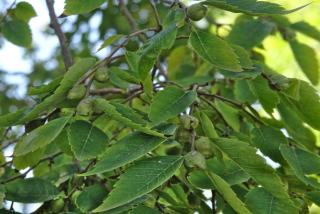

Caucasian elm facts
Name – Zelkova carpinifolia
Family – Ulmaceae
Type – tree
Height – 100 feet (30 meters)
Exposure – full sun
Soil – ordinary
Foliage – deciduous
Flowering – April
Indifferently, in fall or spring.
Follow our guidelines on planting trees.
This is a very hardy tree, down to -10°F (-30°C): it comes from Siberia! Occasionally, it’s called Siberian elm.

In certain botanical gardens, such as in Dublin, Ireland, the tree will produce seeds.
These readily sprout in spring (you can also ask for a sprout or seed if you visit the garden in the right season).
If you wish to reduce the size of the tree or cut off lower branches, best to perform this during the dormant phase of the vegetation, in fall or at the end of winter.
This very elegant tree, which has a majestic bearing when it reaches its adult size, is native to the Caucasian mountains.
It is easy to care for and will endow you with wonder in fall when it becomes gilded with luminous golden yellow leaves.
During its first years, mulch the foot of the tree in summer to retain soil moisture.